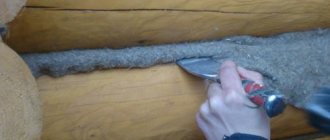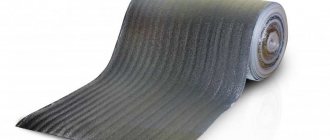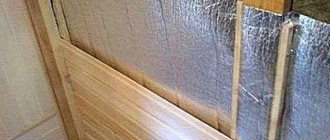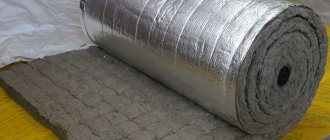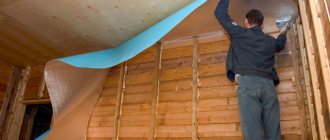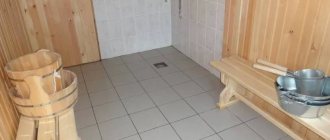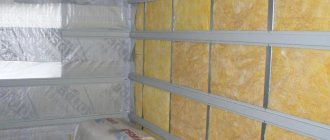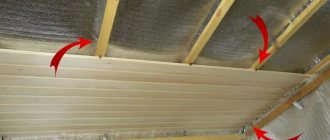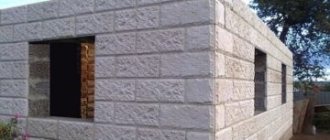There is very little reliable information about the use of foil when decorating a steam room in a bathhouse, which is why myths and disputes about this matter are proliferating on the Internet. Some say that this layer is completely optional. Others hold an even more radical opinion, saying that foil does more harm than good. However, professionals have been using this layer for many years when finishing steam rooms, arguing for its beneficial properties. We propose to understand in more detail why foil is in the bathhouse, and whether it is needed at all.
Classic technology for finishing walls and ceilings in a steam room
If you do not decorate steam rooms every day, then you should start with the general structure of this department. What materials are used here and why. A steam room in a bathhouse is a room with special operating conditions. It contains not just high temperature, but also its regular changes. An even more important aspect is humidity, which constantly changes depending on the current bath mode.
Based on these conditions, the technology for finishing the steam room was developed and perfected over time. As a result, today we have the following arrangement of walls and ceilings in a classic steam room (from the outside to the inside):
- Wall or ceiling.
- Basalt insulation.
- Foil.
- Ventilation gap.
- Lining.
Let us briefly consider each of these layers in terms of its functions. Let's skip the foil for now. We'll talk about the functions of this layer later.
The wall or ceiling is the load-bearing part of the steam room. As a rule, this room is angular in layout, that is, it has two external walls and two partitions. The ceiling in the steam room is arranged in the same way as the walls and partitions, since it experiences the same loads, only to an even greater extent.
Basalt insulation is laid in all surfaces of the steam room, as this has a positive effect on the energy efficiency of the bath and the cost of its maintenance. Usually, for the installation of thermal insulation, the space that is created as a result of installing the sheathing under the lining is used.
Leave the foil out for now.
There simply must be a ventilation gap, since moisture from the steam room partially penetrates behind the lining, and also due to the temperature difference, condensation inevitably collects under the finishing. It is removed in properly designed baths through an exhaust ventilation system.
Lining - performs two important functions. The first is purely decorative. The second is to reflect heat. Since wood is a good heat insulator, even without insulation inside the trim, the lining helps retain heat in the steam room. Actually, thanks to this property, in wooden baths, provided the section of the walls is correctly selected, you can completely do without additional insulation.
Foil and insulation for baths with foil: types
| View | Release form | Peculiarities | Advantages | Flaws |
| Rolled foil | rolls: thickness 0.007-0.2 mm width 1-1.5 m length - 5-20 m | a roll can have from 3 to 5 breaks inside, so take it with a margin of 5-7%; any wall, but place foil on fireproof insulation | does not burn; does not release toxins; holds up to +650 degrees; reflects up to 97% of infrared radiation. | easily torn and wrinkled |
| Kraft foil | rolls reinforced with paper or paper and polyethylene. thickness - 0.03-1 mm | any surfaces, but you also need insulation | does not release toxins; holds up to +100 degrees; stronger than baseless; reflects up to 95% of heat. | flammable |
| Foil fabric | fabric rolls with one-sided foil reinforcement, width - 1 m, length 25 m | similar to the previous one | temperature range -50 +200; thermal reflection 97%; non-flammable; environmentally friendly material. | |
| Folar | rolls in three types of release: “A” - two layers of foil, between them - fiberglass in the form of a mesh with 4x4 cells; “B” - one layer of foil and the same fiberglass; “C” - foil, fiberglass, adhesive base. Roll width 1 m, length 50 m. | “A” temperature range -40 +300 "B" -40 +150 "C" -40 +80 very durable material; environmentally friendly - does not emit toxic substances when heated. | ||
| Folgoizolon | foamed polyethylene, foil-coated on one side. release form: sheets and rolls. sheet: length 120 cm, width 60 cm, thickness 2-11 cm. roll: length up to 30 m, width 1-1.2 m, thickness 0.2-1 cm. | for insulation of wooden walls and walls covered with clapboard | holds 100-150 degrees; self-extinguishes when burning; thick sheets can be independent insulation; light weight; high strength; low thermal conductivity. | flammable |
| Foil mineral wool | mats or rolls of mineral wool with one-sided foil; thickness varies from 0.5 to 10 cm, length and width depend on the manufacturer (there is no single one). | for insulation of walls made of concrete, brick, wood | temperature range -60 +300; reflectivity up to 97%; non-flammable; high thermal insulation properties (thanks to mineral wool). | |
| Foil basalt wool | insulation for baths with foil, a type of mineral wool, the same release forms. | similar to the previous one | properties - similar to the previous one, but basalt wool retains heat better; temperature range -200 +700 degrees. | |
| Foiled polystyrene foam | extruded polystyrene foam boards with one-sided foil coating. | operating temperatures -50 +75 degrees; with the addition of fire retardants - self-extinguishing in case of fire. | flammable; releases harmful substances; | |
| Bath insulation "Rockwool" with foil | stone wool slabs with foil on one side, dimensions 0.6x1 m, thickness 5 or 10 cm. Pack of 8 slabs. | holds up to +200 degrees; biostable; non-flammable; durable; eco-friendly. |
It is worth noting that all of the listed types, which is best for everyone to decide on their own, are excellent vapor barriers. They are not afraid of mold and mildew. But this is for them, and the tree needs an antiseptic.
Why is foil needed here?
At first glance, it may seem that everything that is necessary for the successful operation of the bath is already available (without a layer of foil). It stays warm and beautiful. What else is missing? Actually a lot of things. Firstly, “naked” insulation is absolutely not protected from moisture, which completely renders it unusable over time. Secondly, the energy efficiency of the steam room is not yet the highest possible. Thirdly, the condensate mentioned above will settle on the back side of the lining, which will lead to its rotting in the first year of operation.
And this is where foil comes to the rescue, which many refuse.
Features and Benefits
Taking into account the operational features of various bathhouse premises, thermal insulation made of foil must meet the following requirements:
- High vapor and moisture resistance;
- Excellent fire-resistant properties;
- Resistance to corrosion processes;
- High level of thermal reflectivity (up to 98%) thanks to the mirror top layer;
- Sufficient thermal conductivity;
- Resistant to high temperatures;
- Contains no toxic substances.
High vapor barrier characteristics prevent steam from escaping from the heated room and reduce the likelihood of condensation. This ensures long service life and excellent appearance of the insulation.
- Bath foil has the following advantages:
- Resistance to deformation and ductility during heating;
- Preservation of original consumer characteristics;
- Inert to ultraviolet radiation;
- Protection of premises from condensation, fungal formations and harmful organisms;
- Resistance to chemicals;
- Simplicity and accessibility of installation work;
- Durability, practicality and wear resistance;
- Hygienic and environmentally friendly;
- Affordable price.
Aluminum foil can withstand high temperatures up to 150 degrees, which, in combination with increased reflectivity, helps to effectively retain the generated heat indoors.
Such unique characteristics allow you to create the effect of a thermos in a bathhouse, so the material is ideal for insulating wall, ceiling and floor surfaces in steam rooms and technical rooms.
Reviews of foiled mineral wool
Foil-coated mineral wool can be presented in soft rolled and hard mats. According to experts, this expands the scope of use. Among the main advantages of the first of the mentioned types, according to consumers, a high degree of moisture and vapor barrier should be highlighted.
As for foil wool in the form of rigid mats, they have excellent insulating properties and are easy to install. The thickness of soft rolls can reach 10 mm, and the maximum exposure temperature, as home craftsmen emphasize, is quite high and reaches 125 ° C.
Step-by-step instructions for insulating a bathhouse
To begin with, we note that if the steam room is small, then foil in rolls or kraft foil, the thickness of which is at least 0.3 centimeters, will be quite sufficient. But if the steam room is quite large, then it is better to give preference to materials based on mineral wool. Also, be sure to think about how the condensate will be drained: if the ceiling is insulated, then the foil from it must be taken to the walls, and if the latter are insulated, then to the floor. The overlap should be approximately 15-20 centimeters, and all joints, we repeat, should be taped with metallized tape.
The installation process itself is not complicated and consists of several simple steps. Let's look at the features of each of them in more detail.
Step one. To begin, build a sheathing on the walls using a 5x5 centimeter beam. As for the pitch of the sheathing, in this case it depends on the width of the insulation. If it is 60-120 centimeters, then the step, accordingly, should be 60 centimeters; for foil, the width of which is 100-150 centimeters, this is 50. To attach the bars, use self-tapping screws of a suitable length.
Step two. Place insulating material between the sheathing beams. Try to do this in such a way that the heat insulator does not extend beyond the level of the slats.
Step three. When the main insulation is installed, lay a foil covering on top of it, always placing the latter with a reflective layer inside the room. To seal the joints between the sheets, you can use metallized tape, but remember that the glue, being under prolonged exposure to high temperature, softens, which means that the sheets may well separate, which leads to a violation of the tightness of the entire coating.
It is advisable that the bath foil be fixed with nails or staples - the latter should be nailed directly to the bars. And if the width of the foil is large enough, then it should be fixed both at the edges and in the center.
Step four. Cover the fixed foil with clapboard, not forgetting about the air gap 1.5 centimeters thick. This layer is necessary in order to reduce the thermal conductivity of the foil in order to maximum reflect all the rays that hit the coating back into the room. Obtaining this kind of air “pocket” is possible thanks to the construction of a wooden sheathing under the lining. For this sheathing, try to use bars, the thickness of which is within 1-2 centimeters, and for fixation, use the same self-tapping screws.
Sometimes the sheathing can be built on top of the insulating layer - in this case, the foil will be stuffed immediately over the entire area of the steam room, even onto the beams. If so, then there is no particular need to create air “pockets”, and the lining can be fixed directly to the sheathing. However, practice shows that the use of combined materials, including a foil layer, is preferable not only in economic terms, but also because of the significant simplification of all installation work.
Which foil manufacturer can you trust?
There are a sufficient number of brands on the building materials market that specialize in the production of foil insulation. Among all, three manufacturers can be distinguished.
- Izolon . The concern is located in Izhevsk. Specializes in the production of foil and plastic. Special technologies are used to produce insulation. The material is available in stitched and unstitched form.
- Penofol . This manufacturer produces thin material with no backing. At the same time, the structure is quite strong and reliable.
- URSA . One of the leading manufacturers in Spain. It produces high-quality insulation materials of various thicknesses and structures. This insulator is also sold in Russia.
When choosing a brand, attention is paid to those brands that promise high quality and compliance with all GOSTs.
The remains of the foil sheet can be used in places where the thermal insulation is damaged PHOTO: klevo.net
Reviews of foil in rolls
This material is sold not only in the form of panels. If you want to purchase foil for a bath, you can choose the material in rolls. It is characterized by low cost, which is complemented by ease of installation. Installation of such foil is possible only on fire-resistant heat-insulating material with fastening with metal brackets.
Buyers like that the sheet thickness is minimal and can be 0.5 mm. The roll width is 1500 mm. According to consumers, the temperature range is quite wide and varies from -50 to +75 °C.
Finishing
The insulation for the walls inside the bathhouse with foil cannot be left uncovered. Foil has low strength. In addition, the material can never be installed without a single wrinkle, so this coating looks very mediocre. To eliminate this, a fine finish is applied.
For bathhouses this is traditionally wood. In front finishing it is used in the form of lining (thin board) or block house (thick board with imitation of a log house or timber). Foil under the lining in the bathhouse is an economical and practical solution. The fastening of the front trim is adhesive and with self-tapping screws, which are recessed and sealed with wooden plugs.
Fixing the material
Before installing insulation, it would be a good idea to double-check all the dimensions of the room. If you are installing the foil yourself, without anyone’s help, then it is better to cut the material into separate pieces that will be more convenient for you to handle. For example, meter by meter.
The insulation is installed starting from one of the corners. The staples are placed in increments of 15-20 cm. The overlap of adjacent sheets should be 10-15 cm. The resulting joints must be taped.
Now you know how to insulate the ceiling in a steam room. This simple procedure will improve the performance of your sauna, and will also save time and money.
Criterias of choice
When choosing insulation, you need to consider a number of factors:
- To secure it to a wooden frame, it is better to choose foil with a backing. You can make it yourself from mineral wool, foamed polyethylene, or kraft paper.
- The material must withstand heating up to at least 100°C.
- On the packaging you can read what thermal radiation the foil insulation will reflect. The indicator must be at least 95%.
- The material must be durable.
- The foil and substrate should not emit harmful substances when heated strongly.
Advantages and disadvantages
Advantages:
- environmental cleanliness;
- high reflectivity;
- ease of installation;
- resistance to fungi and mold.
The main disadvantage is low mechanical strength. You need to work with it carefully so as not to damage it.
Features of bath ventilation
As noted earlier, the installation of a high-quality ventilation system is mandatory for the normal functioning of the thermal insulation cake. This should be taken care of in advance - even before proceeding directly to insulation. There are several layouts of holes for ventilation; let’s take a brief look at each of them.
First
We are talking about the circuit indicated in the illustration above by the letter “a”. This is natural ventilation, the supply vent for it is installed at the bottom of the wall next to the heating device, and the exhaust vent is located on top of the opposite one. The option is simple, but its effectiveness leaves much to be desired. For example, some open doors to enhance such ventilation.
Second
Option “b”, in which both vents are located on the same wall, and the heating device is located on the opposite wall. Suitable for baths with one outer wall. To strengthen the system, a fan is used (in the inlet).
Third
As for option “c”, it must be implemented during the construction of the bathhouse, since in this case the air will move under the finished floor. The location of the ventilation windows is the same as in option No. 1, but the fan should be located in the exhaust hole (the one on top). It's a fairly effective system, it's worth noting.
Reviews about laminated foil
Another type of foil is laminated aluminum material, which is made by combining polyethylene, paper and foil. As a result, it is possible to obtain a layer that, according to consumers, has high barrier properties.
The fabrics have impressive impermeability to vapor and gases. If we compare with a film, then with a thickness of 9 microns it will have a water vapor throughput of 0.1 g per m2 per day. Buyers like the high hygienic characteristics of laminated foil. In humid conditions, the surface will not create a breeding ground for the development of mytoxins and microflora. It is impossible not to mention elasticity. This material resists compressive loads while maintaining its original shape.
Among the main types of laminated foil, we should highlight kraft paper with foil, which is a three-layer lamination material. Its first layer is kraft paper, the second is thin polyethylene, while the third is aluminum foil itself. Kraft paper is made from long-fiber cellulose by flattening and the use of chemical salts.
According to users, kraft paper is dense, wear-resistant and mechanically strong. As for polyethylene, it has impressive thermoplastic, vapor barrier and water-repellent properties. Foil performs its main function - it reflects heat into the room.
If you purchase Chinese-made material, you will have to pay $26 per sheet. Laminated foil from European manufacturers is more expensive – $45 per sheet. Domestic manufacturers offer foil on kraft paper for $20 per sheet.
Thermal requirements for a bathhouse building
The bathhouse building must warm up quickly and retain heat for a long time, but at the same time use fuel economically. Such conflicting requirements force builders to think carefully about solving the problem. Fuel for the stove must be high-calorie. All heat produced must remain indoors. All routes for its leakage must be blocked.
From the point of view of a heating engineer, heat in a bathhouse is distributed by convection (the movement of hot air), heat transfer (from one heated body to another with close contact) and infrared rays (low-frequency electromagnetic waves).
Foil is proposed as a heat reflector (infrared transmission) back into the bathhouse. But the foil itself turns out to be shielded from the stove, and infrared rays almost do not reach it. So it reflects only a small fraction of the heat produced by the stove. But foil, when laid correctly, can cover all the cracks and prevent hot air from escaping. The joints of the foil sheets are glued with special foil tape. It is also good.
Criterias of choice
When choosing insulation, you need to consider a number of factors:
- To secure it to a wooden frame, it is better to choose foil with a backing. You can make it yourself from mineral wool, foamed polyethylene, or kraft paper.
- The material must withstand heating up to at least 100°C.
- On the packaging you can read what thermal radiation the foil insulation will reflect. The indicator must be at least 95%.
- The material must be durable.
- The foil and substrate should not emit harmful substances when heated strongly.
Advantages and disadvantages
Advantages:
- environmental cleanliness;
- high reflectivity;
- ease of installation;
- resistance to fungi and mold.
The main disadvantage is low mechanical strength. You need to work with it carefully so as not to damage it.
Manufacturers and prices
Manufacturers:
- URSA;
- "Izolon";
- "Penofel".
The average price of 1 roll is 600 rubles.
Additional properties of polystyrene foam with a foil layer
This material is combined and consists of polyethylene foam with a closed porous structure. It is supplemented with aluminum foil. The canvases are used as noise insulation and thermal protection material for interior and exterior work. The combination of these layers allows for economical and efficient finishing of baths and saunas. Among the main properties it is worth highlighting:
- shock-absorbing qualities;
- health safety;
- vapor barrier properties;
- ability to reflect heat up to 98%;
- long working life;
- chemical resistance.
Minuses
Disadvantages are also important to consider. If you attach foil to a cold wall, the material will show itself negatively. It is imperative to use an additional insulating layer between the wall and the foil.
There is no point in using foil for those who do not save on fuel and who do not care about long heating times. There is no benefit from foil if the bathhouse is sufficiently insulated with other materials.
The absence of foil makes the steam softer and there is no sharp water hammer. For example, sauna logs without foil smooth out temperature shocks well.
Aluminum accumulates in the body. This has a bad effect on a person’s condition and well-being. The metal accumulates in the lungs and negatively affects them. Remember also about aluminum cookware and why almost everyone refuses it. When heated, aluminum cookware releases metal ions. When eating food, aluminum gets ingested.
Source of the article: https://zen.yandex.ru/media/remonts/ne-obshivaite-folgoi-baniu-problemy-i-vred-aliuminievoi-folgi-5f3f4542feee9a1c2fb80edb
Installation of foil on the ceiling
After reading reviews about bath foil, you can understand that it has a wide range of uses. It can be installed not only on walls, but also on the ceiling. To do this, it is covered with rolled paper with wide overlaps. At the next stage, the paper is fixed with square bars with a side of 5 cm. Insulation is installed between them.
The next step is to install the foil. She will close the insulator. It is important to ensure 100% solidity. Fastening is carried out with adhesive tape, which can be purchased at a hardware store. Quite often it is implemented together with foil.
Among such tapes there are low-quality ones. Checking this is quite simple: you need to glue a piece of material to a piece of foil and try to tear it off. If you have ordinary tape in your hands, then the task will not be so easy. If you want to know in detail how to sheathe the inside of a bathhouse with foil, then the edges and joints must be carefully fixed. This is necessary to prevent moisture penetration. It is important to achieve tightness.
Instead of aluminum foil, you can use wax paper or thick cardboard. It is pre-impregnated with drying oil. But on such a vapor barrier it will be necessary to lay a layer of clay, only then can insulation begin. The foil is fixed with bars with a cross section of 2 x 3 cm. This will allow you to maintain air exchange, and in the future you can install decorative trim on the bars.
Key features of insulation: what do you need to know?
Before proceeding directly with insulation, you should learn about the rules for its implementation, as well as what you must pay attention to. So that the foil takes part in maintaining the required indoor microclimate, consider the following important points.
- The room must have good ventilation. Otherwise, all thermal insulation layers will become saturated with moisture and lose their original characteristics. The foil material itself will simply become useless.
- There must be ventilation gaps between the finishing material and the insulating layers.
- Attach all layers correctly, in accordance with the requirements, also do not forget to seal the joints between the sheets.
Remember that if you do not fulfill at least one of the listed requirements, then all your efforts will probably be wasted, and the final thermal and sound insulation properties of the foil will be practically zero.
Ventilation of bath rooms
Before insulating the steam room, a ventilation system is designed. For room ventilation, natural or forced systems are used.
- Ventilation is arranged with one lower hole, opposite the flue stove mounted on the wall. The heated steam rises and cools. It is mixed with the incoming fresh flow from the inlet window and drawn out by the stove's blower system.
- The heating furnace can be installed below the level of the floor covering, so that the blower system is located in the gap between the floor and the insulation. The entrance windows are located at the top of the basement and in the flooring of the bathhouse. The air passes through the underground passage, into the steam room and is drawn into the stove's ash system.
- The supply window is mounted at the bottom of the steam room next to the heating system. To prevent a draft from forming, an exhaust window is installed at the top behind the partition. The natural system is equipped with a device that regulates air flow.
- The use of such ventilation does not deliver the expected effect because the air quickly heats up when entering, rises up and is drawn out. For additional fresh air, the doors are opened, which is unacceptable when taking the procedure.
- You can install ventilation on one end wall, opposite the heating system. The incoming air flow is further enhanced by a fan, this type of ventilation is called forced ventilation.
- For efficient ventilation, windows are placed in opposite lower planes. The exhaust ventilation window is additionally equipped with a fan. After entering the room, heated air rises to the ceiling, cools and is drawn out by a fan.
There are three holes for air flow for efficient air exchange:
- one window downstairs, near the stove;
- another window in the floor, where there is a gap between the floor of the room and the insulation;
- the third hole is on the opposite wall from the stove in the upper part.
A device for forced ventilation is installed in the upper window. The window area is calculated based on the area of the bathhouse: per 1 m² - volume 24 cm².
Only properly installed room ventilation will extend the life of the sauna room.
Thickness of walls and insulation used
The insulating effect is obtained by using paper-based foil correctly, taking into account its thickness. This table is used to determine:
| Wall composition | Wall thickness, mm | Material thickness, mm |
| Concrete | 350-370 | 80-100 |
| Brick | 250-350 | 100-150 |
| Wooden log house | 100-150 | 60-80 |
| Wooden log house | 150-200 | 40-60 |
| Wooden log house | From 200 | up to 40 |
This calculation involves the development of insulation for the walls of baths and saunas. The reflective layer of aluminum is mounted only indoors.
